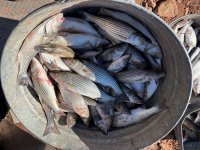Dan Keller
UT DWR Fish Biologist
I wanted to share a quick update on the UDWR gillnetting survey we complete each November. We know years with poor spring run off results in low shad survival due to less nutrients to support zooplankton populations and a lack of flooded vegetation for young shad to hide and escape predation. Due to poor spring runoff shad spawning and survival was diminished in 2025; the older age classes of striped bass have been dying off since early spring; they simply can't find enough shad to survive. Fortunately, young striped bass eat zooplankton their first year in the lake, so they survive better than older fish and are in a good position to grow quickly after competition decreases post recent die offs of older age striped bass. Our fall gillnets found a robust population of 1.5-3.5 year old striped bass, and not surprising a very apparent lack of older fish. Here is a picture of the typical striped bass catch in a gillnet, you can see the 3 age classes most represented in the lake currently.

We did get a few older fish, many were in good condition, indicating that the die off of skinny striped bass we observed over the summer is over. We checked stomach contents of all sport fish and found many are still feeding heavily on crayfish. We see higher crayfish predation when shad numbers are down.

Walleye had a higher percentage of bluegill and green sunfish in their diet than we typically observe. During these low shad conditions anglers might catch a few more fish by using colors and lures that imitate sunfish and crayfish. Our nets at Red Canyon had the highest percentage of Walleye with 14% of the total catch being Walleye. The San Juan had the second greatest number of Walleye representing 13.6% of the total catch.
We also finished our 7-month angler survey that was conducted at Bullfrog and Wahweap. I’m sure many of you saw us on the boat ramps and took the time to be interviewed and answer our questions about your fishing trip. Thank you very much to all those that participated in the angler survey, the data greatly helps us understand how anglers are experiencing the lake and if management strategies are working or need to be modified. I will share more results of the angler survey when I have the data organized, however one quick finding of interest is that while total angler effort was lower this year compared to previous years the catch rates of many species were greater that average. September was the best month for catch rates, during that month anglers reported catching an average of 4.6 fish per hour. Fishing for all species will remain good for several more weeks, after that cold temps will slow down warm water species metabolisms, you can still catch them, but they will be deeper and less active. Catching good numbers of striped bass is possible all winter by located schools holding in deep water and vertical jigging with spoons or soft plastic swimbaits. Trolling diving crankbaits over points during November can also be effective for stripers, walleye, and smallmouth bass. If you have never made a late season / winter trip to Lake Powell give it a try, it’s a fantastic time to visit the Lake!

We did get a few older fish, many were in good condition, indicating that the die off of skinny striped bass we observed over the summer is over. We checked stomach contents of all sport fish and found many are still feeding heavily on crayfish. We see higher crayfish predation when shad numbers are down.

Walleye had a higher percentage of bluegill and green sunfish in their diet than we typically observe. During these low shad conditions anglers might catch a few more fish by using colors and lures that imitate sunfish and crayfish. Our nets at Red Canyon had the highest percentage of Walleye with 14% of the total catch being Walleye. The San Juan had the second greatest number of Walleye representing 13.6% of the total catch.
We also finished our 7-month angler survey that was conducted at Bullfrog and Wahweap. I’m sure many of you saw us on the boat ramps and took the time to be interviewed and answer our questions about your fishing trip. Thank you very much to all those that participated in the angler survey, the data greatly helps us understand how anglers are experiencing the lake and if management strategies are working or need to be modified. I will share more results of the angler survey when I have the data organized, however one quick finding of interest is that while total angler effort was lower this year compared to previous years the catch rates of many species were greater that average. September was the best month for catch rates, during that month anglers reported catching an average of 4.6 fish per hour. Fishing for all species will remain good for several more weeks, after that cold temps will slow down warm water species metabolisms, you can still catch them, but they will be deeper and less active. Catching good numbers of striped bass is possible all winter by located schools holding in deep water and vertical jigging with spoons or soft plastic swimbaits. Trolling diving crankbaits over points during November can also be effective for stripers, walleye, and smallmouth bass. If you have never made a late season / winter trip to Lake Powell give it a try, it’s a fantastic time to visit the Lake!
